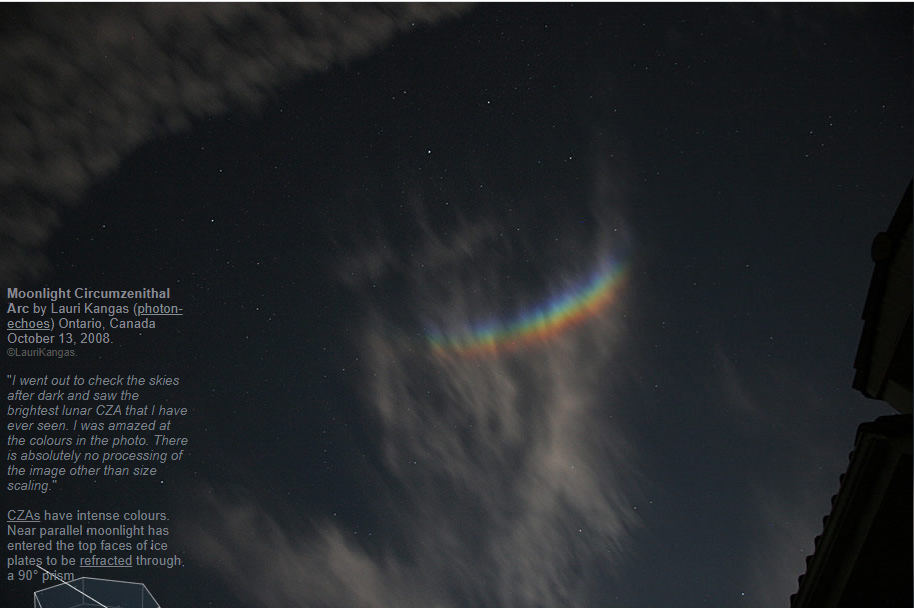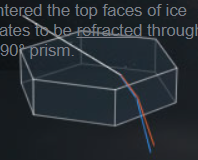Moonlight CZA
Moonlight Circumzenithal Arc: A Spectacular Atmospheric Phenomenon
Have you ever gazed up at the night sky and been captivated by the ethereal beauty of the moon? While the moon itself is a sight to behold, sometimes it brings along with it an extraordinary atmospheric phenomenon known as the Moonlight Circumzenithal Arc (CZA). In this article, we will delve into the fascinating world of CZAs, exploring their formation, colors, and the sheer wonder they evoke.
What is a Moonlight Circumzenithal Arc?
A Moonlight CZA is a rare and breathtaking optical display that occurs when moonlight interacts with ice crystals in the Earth's atmosphere. It takes the form of a vividly colored arc that appears above the moon, resembling an upside-down rainbow. Unlike a traditional rainbow that forms from sunlight, CZAs are exclusively created by moonlight.
The Formation of Moonlight CZAs
To understand how CZAs form, we need to explore the behavior of light as it passes through ice crystals suspended in the atmosphere. When moonlight enters the top faces of these ice plates, it undergoes refraction, bending at an angle. As the light passes through the ice crystals, it is refracted again, creating a 90° prism effect. This refraction and prism effect give rise to the magnificent Moonlight CZA.
The Vibrant Colors of Moonlight CZAs
One of the most striking features of a Moonlight CZA is its intense colors. The combination of the moonlight's parallel rays and the refraction through ice crystals results in vibrant hues. The arc often exhibits shades of red, green, and blue, with red appearing on the inner edge and blue on the outer edge. The colors are a result of the dispersion of light as it passes through the ice crystals, similar to how sunlight creates a spectrum of colors in a traditional rainbow.
Rare Occurrence and Optimal Viewing Conditions
Moonlight CZAs are considered rare and are often regarded as a special treat for those lucky enough to witness them. Several factors contribute to their rarity. Firstly, CZAs can only occur when the moon is high in the sky, typically around 22° or more above the horizon. Secondly, the presence of ice crystals in the atmosphere is necessary for the formation of CZAs. These ice crystals are usually found in high-altitude cirrus clouds, making their occurrence dependent on specific weather conditions.
Moonlight CZAs vs. Sunlight Rainbows
While CZAs share similarities with traditional rainbows, there are notable differences between the two. Moonlight CZAs are typically smaller and more compact than rainbows, often appearing as a narrow arc above the moon. Additionally, CZAs tend to exhibit more intense colors due to the parallel nature of moonlight rays and the unique prism effect created by ice crystals.
Photographing Moonlight CZAs
Capturing the ephemeral beauty of a Moonlight CZA in a photograph can be a challenge, but the results can be truly mesmerizing. Photographers often rely on long-exposure techniques to capture the subtle nuances of color and detail. It is important to note that minimal processing of the image is necessary to preserve the authenticity of the CZA's colors and structure.
The Magic of Moonlight CZAs
Moonlight CZAs are not only a visual spectacle but also a testament to the complex interplay between light and atmospheric conditions. They remind us of the wonders that can occur when we take a moment to look up and appreciate the beauty of our natural world. So, the next time you find yourself under a moonlit sky, keep your eyes peeled for this rare and awe-inspiring phenomenon – you might just be fortunate enough to witness the enchanting Moonlight Circumzenithal Arc.

Moonlight Circumzenithal Arc by Lauri Kangas (photon-echoes) Ontario, Canada October 13, 2008. ©LauriKangas.
"I went out to check the skies after dark and saw the brightest lunar CZA that I have ever seen. I was amazed at the colours in the photo. There is absolutely no processing of the image other than size scaling."
CZAs have intense colours. Near parallel moonlight has entered the top faces of ice plates to be refracted through a 90° prism.

Note: this article has been automatically converted from the old site and may not appear as intended. You can find the original article here.
Reference Atmospheric Optics
If you use any of the definitions, information, or data presented on Atmospheric Optics, please copy the link or reference below to properly credit us as the reference source. Thank you!
-
<a href="https://atoptics.co.uk/blog/moonlight-cza/">Moonlight CZA</a>
-
"Moonlight CZA". Atmospheric Optics. Accessed on April 20, 2024. https://atoptics.co.uk/blog/moonlight-cza/.
-
"Moonlight CZA". Atmospheric Optics, https://atoptics.co.uk/blog/moonlight-cza/. Accessed 20 April, 2024
-
Moonlight CZA. Atmospheric Optics. Retrieved from https://atoptics.co.uk/blog/moonlight-cza/.